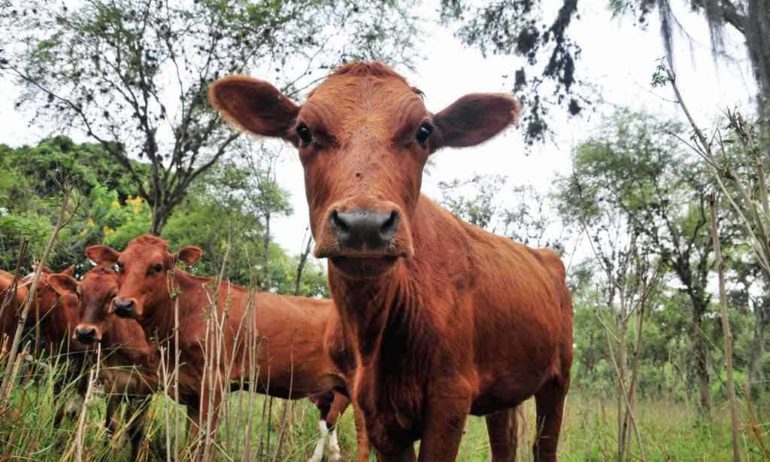Hacienda Pinzacuá is a family farm in the Valle de Cauca region of Colombia using agroforestry to keep their farm healthy and sustainable. Food Tank recently had the opportunity to speak with Irene Montes Londoño, whose father started Hacienda Pinzacuá. Montes was recently admitted to the Yale School of Forestry and Environmental Sciences to study agroforestry.
Food Tank (FT): What motivated your family to begin farming sustainably?
Irene Montes Londono (IML): For 150 years, coffee was produced in Colombia in agroforestry systems with agroecological practices. Both of my grandfathers were sustainable coffee producers and were able to comfortably sustain a big family, pay for a good education for their children, and buy new land every year; all that, only with the income from their farms.
When my father began farming, he was doing well and he could save money to buy his own land and Hacienda Pinzacuá. But when a fungus devastated the coffee crop, he had to switch to a new variety that required cutting down all the shade trees and using high amounts of fertilizer. The yields were high, but so were the costs of the inputs he had to put into the crop.
We tried to make this system work, but every year we had to increase the amount of fertilizer because the soil was getting heavily depleted. That is when my father realized that the problem was not the crop, it was the model.
In 1998, my father started a new experiment at the farm: he stopped using fertilizers and started planting trees. In 2000, a local NGO called CIPAV (Research Center of Sustainable Agricultural Production Systems) came to visit us. They offered us technical assistance and payment for environmental services; they let us know we were not alone in this journey, and they connected us to a global network of farmers, universities and organizations that share our values and mission.
FT: How is Hacienda Pinzacuá using agroforestry to be more sustainable?
IML: Trees replenished soil fertility by fixing nitrogen into the soil and by promoting nutrient cycling; thus, saving us money on fertilizers and similar products. An additional benefit gained from enhanced soil fertility is increased grass potency which means a stronger and more aggressive plant that allows it to compete with most weeds. The shade created by the trees protects the cattle from direct sunlight. The biodiversity achieved creates a system that regulates itself by the generation of natural agents that control ticks and fly. These pests, if not managed appropriately, cause weight loss and ultimately death to the animal.
Last but not least, the farm has been able to diversify its production by producing native hardwoods and high-value timber. We also produce honey in an apiary kept in the farm to enable pollination. And because our soils are healthy, and our system has achieved a considerable level of biodiversity, we are now adventuring into high-value crops such as vanilla, pepper, cardamom and flowers.
In summary, we are more competitive and less vulnerable to extreme weather events because the system allows soil to retain water for longer periods and has created a microclimate that protects soil from drought. We are resilient.
FT: You’ve recently been admitted to the Yale School of Forestry and Environmental Studies. Can you talk about the research you’ll be undertaking while at Yale?
IML: I want to assess the economic value of native timbers in agroforestry and silvopastoral systems.The majority of farmers don’t realize the potential in planting these trees in their farms. This information could be used as a convincing argument for farmers who are still hesitant about implementing these systems, and could be used to make the business case for impact investors to partner with smallholder farmers who don’t have the money or access to credit to implement these systems at their farms.
While at Yale, I will also be studying other aspects of agroforestry systems that deal more with the technical aspects one encounters when implementing these kinds of systems, i.e., silvicultural and ecological aspects. Some of the questions I am looking to answer are: What is the most effective and efficient way to arrange the different species in a mixed plantation? What is the ideal ratio of number of cattle vs. number of trees per hectare? When do the thinning and pruning need to be made and how? These questions, as well as other market-related questions, need to be answered to make an accurate economic assessment.
FT: What role does agroecology play in creating a healthier and more sustainable food system?
IML: Agroecology is about conferring equal importance to the soil and the rest of the living and nonliving elements integrating the agricultural production system, including humans. Each region, each farm has its set of ideal practices adequate for its particular social, environmental and political context. No universal recipes, no universal formulas. I believe that this flexible, holistic approach is the foundation for creating a healthier and more sustainable food system.
FT: What is the number one thing individuals can do to support sustainable agriculture?
IML: I think that for people living in cities, the first step is to pay more attention to the food they eat and how it is related to their physical and mental health. Then, learn key terms and principles that can help you make more informed decisions about the food you eat. I recently stumbled upon this series of short videos called The Lexicon of Sustainability, which I think are a great way to learn how to live more sustainable lives. A visit to a local farm during the weekend is always a good way to reconnect with nature and ourselves and learn about where our food comes from.











